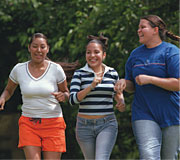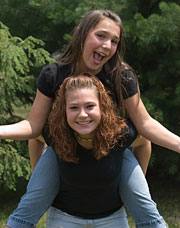Tips for Teens with Diabetes: Be Active
Download This Publication (NDEP-64)
Want this item now? Download it here:
Print this Publication (NDEP-64)
To print large quantities of a publication, you can order printer-ready files for $20 each by calling 1-800-860-8747.
Order this Publication (NDEP-64)
To order a copy of this publication, select quantity and "add to cart".
- Hide order info
-
Single copies up to 10 copies, free. Each additional package of 10, $2. Limit 100 copies (10 packages).

This tip sheet provides useful information about diabetes and encourages teens to take action to manage their disease for a long and healthy life.
Last reviewed: 02/02/2012
What’s so important about being physically active?

Being active keeps your body healthy and strong and gives you more energy. It can help you think and be more alert in school. It can also help you stay at a healthy weight or help you lose weight slowly. Being active is an important part of a healthy lifestyle.
Physical activity can make you feel better if you are in a bad mood or stressed out. It can relax you and help you sleep well. It helps your body use blood glucose, also called blood sugar, for energy. Physical activity can help keep your blood glucose in a normal range.
What activities can I do?
There are many ways you can be active. Pick things you like to do.
Take a walk, hike, or ride a bike.
Skateboard, roller blade, or ice skate.
Play some music and dance with your friends. If you like video games, try a dance or other active video game.
Play basketball, baseball, softball, golf, soccer, tennis, volleyball, or your favorite sport.
Go bowling.
Think of other things you like to do and just move! It is an easy way to have fun.
Make physical activity a part of your daily life. Be active with your friends or family members. It is easier and more fun when you ask someone to join you.
How active should I be?

If you have not been very active in the past, start slowly. Try a few minutes each day. Do not get upset if you cannot do a lot or if you get out of breath at first—keep moving. Any amount of activity will help. Slowly work up to at least 60 minutes everyday. You might find it fun to count your steps with a pedometer (step counter). Add a few more steps each day. Over time, work up to at least 10,000 steps a day.
What should I do before being more active?
Talk to your doctor about the types of physical activity that might work best for you.
Check your blood glucose before the start and after the end of your activity.
If you take insulin, make sure your blood glucose does not get too low during or after activity. Always wear a Medical ID bracelet.
Keep something handy to treat low blood glucose, such as fruit juice, glucose tablets, or a snack.
But I hate to exercise - what can I do?

You do not have to play a sport or go to a gym. There are a lot of things you can do to be more active:
Do sit-ups or jump rope while watching TV.
Lift light weights to strengthen your muscles.
Jog around the block or walk fast around the mall a few times.
Help your mom or dad carry groceries, clean the house, cut grass, do garden work, rake leaves, or shovel snow.
Take the stairs instead of the elevator.
Take your dog for a walk.
- Ride your bike instead of driving or getting a ride from your parents or a friend.
Make a list of things you like to do to be physically active. Hang it in your room as a reminder. Keep track of your progress.
Who can help me be more active?
Ask your family members and friends to do something fun with you—and work up a sweat. Being active is good for them too and a great way for families to spend time together. Ask your family to take a walk after dinner instead of watching TV. Instead of computer games, play music that the whole family likes and dance!
Start an activity group with your friends. Try a different sport or activity each week, or simply walk home from school together instead of taking the bus.
Tips for parents

to promote physical activity for teens in their community
Talk to school staff about allowing more activity time for students.
Ask if you can schedule physical activities such as karate or dance at the school during after-school hours.
Involve your family in active programs like the YMCA, swim clubs, 4H, Boy or Girl Scouts, Boys & Girls Clubs, and youth recreation programs.
Talk to local leaders about making safe places for teens to be active.
Volunteer to help create or fix up public playgrounds or sports grounds.
How can I manage my diabetes?
If you have diabetes, you need to be active, make healthy food choices, and stay at a healthy weight. You also need to take your insulin or any other medicines that your doctor tells you to and check your blood glucose as planned with your health care team. Taking care of your diabetes can help you stay fit, feel great, and give you more energy to have fun.
Application Required
PDF files require the
free Adobe Acrobat Reader![]() application for viewing.
application for viewing.
WMV is Video file in Windows Media Player format. Download the free Windows Media Player![]() application for viewing.
application for viewing.
MP3 is Music file. Download the free Windows Media Player![]() application for viewing.
application for viewing.
All our publications are copyright-free. Please duplicate and distribute as many copies of these materials as desired. Online information may be more recently updated than printed materials.
Attention visually impaired visitors: To use common screen
reading programs with PDF documents, please visit Accessibly Resource Center![]() , which provides a set of free tools that convert PDF
documents to simple HTML or ASCII text.
, which provides a set of free tools that convert PDF
documents to simple HTML or ASCII text.
